Social Sustainability Assessment across Provinces in China: An Analysis of Combining Intermediate Approach with Data Envelopment Analysis (DEA) Window Analysis
Abstract
:1. Introduction
2. Literature Review
3. China’s Regional Gaps and Current Environmental Policies
3.1. China’s Regional Disparity
3.2. China’s Current Environmental Policies
4. Methodology
4.1. The Production Technology Set and the Disposability Concepts
4.2. Intermediate Approach and Unified Efficiency
4.3. Window Analysis
4.4. Performance Indices of Inputs and Outputs
5. The Empirical Results
5.1. The Data
5.2. Unified Efficiency Measures
5.2.1. Results of Natural Disposability
5.2.2. Results of Managerial Disposability
5.3. The Efficiency of Aggregate Pollutants
5.3.1. Results under Natural Disposability
5.3.2. Results of Managerial Disposability
5.4. Comparing the Performance across Pollutants
5.4.1. The Relative Efficiency Index of RII
5.4.2. The Relative Efficiency Index of RETI
6. Conclusions
Acknowledgments
Author Contributions
Conflicts of Interest
References
- BP. Statistical Review of World Energy. 2017. Available online: http://www.bp.com/statisticalreview (accessed on 19 August 2017).
- IEA. CO2 Emissions from Fuel Combustion, 2016th ed.; IEA: Paris, France; Available online: http://www.iea.org/publications/freepublications/publication/CO2EmissionsfromFuelCombustion_Highlights_2016.pdf (accessed on 16 August 2017).
- National Bureau of Statistics of China. China Statistical Yearbook on Environment 2006–2015; China Statistics Press: Beijing, China, 2006–2015.
- Yao, X.; Zhou, H.; Zhang, A.; Li, A. Regional energy efficiency, carbon emission performance and technology gaps in China: A meta-frontier non-radial directional distance function analysis. Energy Policy 2015, 84, 142–154. [Google Scholar] [CrossRef]
- Li, A.; Peng, D.; Wang, D.; Yao, X. Comparing regional effects of climate policies promoting non-fossil fuels in China. Energy 2017, 141, 1998–2012. [Google Scholar] [CrossRef]
- Li, A.; Zhang, A.; Zhou, Y.; Yao, X. Decomposition analysis of factors affecting carbon dioxide emissions across provinces in China. J. Clean. Prod. 2017, 141, 1428–1444. [Google Scholar] [CrossRef]
- Zhang, Z.; Zhang, A.; Wang, D.; Li, A.; Song, H. How to improve the performance of carbon tax in China? J. Clean. Prod. 2017, 142, 2060–2072. [Google Scholar] [CrossRef]
- Sueyoshi, T.; Goto, M. A comparative study among fossil fuel power plants in PJM and California ISO by DEA environmental assessment. Energy Econ. 2013, 40, 130–145. [Google Scholar] [CrossRef]
- Sueyoshi, T.; Goto, M. DEA environmental assessment in a time horizon: Malmquist index on fuel mix, electricity and CO2 of industrial nations. Energy Econ. 2013, 40, 370–382. [Google Scholar] [CrossRef]
- Sueyoshi, T.; Goto, M. Japanese fuel mix strategy after disaster of Fukushima Daiichi nuclear power plant: Lessons from international comparison among industrial nations measured by DEA environmental assessment in time horizon. Energy Econ. 2015, 52, 87–103. [Google Scholar] [CrossRef]
- Sueyoshi, T.; Yuan, Y. Social sustainability measured by intermediate approach for DEA environmental assessment: Chinese regional planning for economic development and pollution prevention. Energy Econ. 2017, 66, 154–166. [Google Scholar] [CrossRef]
- Sueyoshi, T.; Yuan, Y.; Li, A.; Wang, D. Social Sustainability of Provinces in China: A Data Envelopment Analysis (DEA) Window Analysis under the Concepts of Natural and Managerial Disposability. Sustainability 2017, 9, 2078. [Google Scholar] [CrossRef]
- Charnes, A.; Cooper, W.W.; Rhodes, E. Measuring the efficiency of decision making units. Eur. J. Oper. Res. 1978, 6, 429–444. [Google Scholar] [CrossRef]
- Cooper, W.W.; Seiford, L.M.; Zhu, J. Data Envelopment Analysis: History, Models, and Interpretations. In Handbook on Data Envelopment Analysis; Springer: Berlin, Germany, 2004; Volume 2, pp. 1–39. [Google Scholar]
- Coelli, T.J.; Rao, D.S.P.; O’Donnell, C.J.; Battese, G.E. An Introduction to Efficiency and Productivity Analysis, 2nd ed.; Springer: New York, NY, USA, 2005. [Google Scholar]
- Sueyoshi, T.; Goto, M. Environmental Assessment on Energy and Sustainability by Data Envelopment Analysi; John Wiley & Sons: London, UK, 2018; pp. 1–704. [Google Scholar]
- Färe, R.; Grosskopf, S.; Norris, M.; Zhang, Z. Productivity Growth, Technical Progress, and Efficiency Change in Industrialized Countries. Am. Econ. Rev. 1994, 84, 66–83. [Google Scholar]
- Barros, C.P.; Managi, S.; Matousek, R. The technical efficiency of the Japanese banks: Non-radial directional performance measurement with undesirable output. Omega 2012, 40, 1–8. [Google Scholar] [CrossRef]
- Zhou, P.; Ang, B.W.; Wang, H. Energy and CO2 emission performance in electricity generation: A non-radial directional distance function approach. Eur. J. Oper. Res. 2012, 221, 625–635. [Google Scholar] [CrossRef]
- Zhang, J.; Liu, Y.; Chang, Y.; Zhang, L. Industrial eco-efficiency in China: A provincial quantification using three-stage data envelopment analysis. J. Clean. Prod. 2017, 143, 238–249. [Google Scholar] [CrossRef]
- Zhang, N.; Kong, F.; Choi, Y.; Zhou, P. The effect of size-control policy on unified energy and carbon efficiency for Chinese fossil fuel power plants. Energy Policy 2014, 70, 193–200. [Google Scholar] [CrossRef]
- Zhang, Y.J.; Hao, J.F.; Song, J. The CO2 emission efficiency, reduction potential and spatial clustering in China’s industry: Evidence from the regional level. Appl. Energy 2016, 174, 213–223. [Google Scholar] [CrossRef]
- Tapia, J.; Promentilla, M.; Tseng, M.; Tan, R. Screening of carbon dioxide utilization options using hybrid Analytic Hierarchy Process-Data Envelopment Analysis method. J. Clean. Prod. 2017, 165, 1361–1370. [Google Scholar] [CrossRef]
- Liu, X.; Chu, J.; Yin, P.; Sun, J. DEA cross-efficiency evaluation considering undesirable output and ranking priority: A case study of eco-efficiency analysis of coal-fired power plants. J. Clean. Prod. 2017, 142, 877–885. [Google Scholar] [CrossRef]
- Bi, G.; Shao, Y.; Song, W.; Yang, F.; Luo, Y. A performance evaluation of China’s coal-fired power generation with pollutant mitigation options. J. Clean. Prod. 2018, 171, 867–876. [Google Scholar] [CrossRef]
- Zhou, P.; Sun, Z.R.; Zhou, Q. Optimal path for controlling CO2 emissions in China: A perspective of efficiency analysis. Energy Econ. 2014, 45, 99–110. [Google Scholar] [CrossRef]
- Sueyoshi, T.; Yuan, Y.; Li, A.; Wang, D. Methodological Comparison among Radial, Non-radial and Intermediate Approaches for DEA Environmental Assessment. Energy Econ. 2017, 67, 439–453. [Google Scholar] [CrossRef]
- Bowlin, W.F. Evaluating the Efficiency of US Air Force Real-Property Maintenance Activities. J. Oper. Res. Soc. 1987, 38, 127–135. [Google Scholar] [CrossRef]
- Thore, S.; Kozmetsky, G.; Phillips, F. DEA of Financial Statements Data: The U.S. Computer Industry. J. Product. Anal. 1994, 5, 229–248. [Google Scholar] [CrossRef]
- Goto, M.; Tsutsui, M. Comparison of Productive and Cost Efficiencies among Japanese and US Electric Utilities. Omega 1998, 26, 177–194. [Google Scholar] [CrossRef]
- Sueyoshi, T.; Aoki, S. A use of a nonparametric statistic for DEA frontier shift: The Kruskal and Wallis rank test. Omega 2001, 29, 1–18. [Google Scholar] [CrossRef]
- Yang, W.C.; Lee, Y.M.; Hu, J.L. Urban sustainability assessment of Taiwan based on data envelopment analysis. Renew. Sustain. Energy Rev. 2016, 61, 341–353. [Google Scholar] [CrossRef]
- Vlontzos, G.; Pardalos, P.M. Assess and prognosticate green house gas emissions from agricultural production of EU countries, by implementing, DEA Window analysis and artificial neural networks. Renew. Sustain. Energy Rev. 2017, 76, 155–162. [Google Scholar] [CrossRef]
- Bian, Y.W.; Yang, F. Resource and environment efficiency analysis of provinces in China: A DEA approach based on Shannon’s entropy. Energy Policy 2010, 38, 1909–1917. [Google Scholar] [CrossRef]
- Guo, X.D.; Zhu, L.; Fan, Y.; Xie, B.C. Evaluation of potential reductions in carbon emissions in Chinese provinces based on environmental DEA. Energy Policy 2011, 39, 2352–2360. [Google Scholar] [CrossRef]
- Wang, K.; Wei, Y.M.; Zhang, X. A comparative analysis of China’s regional energy and emission performance: Which is the better way to deal with undesirable outputs? Energy Policy 2012, 46, 574–584. [Google Scholar] [CrossRef]
- Wu, F.; Fan, L.W.; Zhou, P.; Zhou, D.Q. Industrial energy efficiency with CO2 emissions in China: A nonparametric analysis. Energy Policy 2012, 49, 164–172. [Google Scholar] [CrossRef]
- Wang, Q.W.; Zhao, Z.Y.; Zhou, P.; Zhou, D.Q. Energy efficiency and production technology heterogeneity in China: A meta-frontier DEA approach. Econ. Model. 2013, 35, 283–289. [Google Scholar] [CrossRef]
- Wang, K.; Wei, Y.M. China’s regional industrial energy efficiency and carbon emissions abatement costs. Appl. Energy 2014, 130, 617–631. [Google Scholar] [CrossRef]
- Wang, Z.H.; Feng, C.; Zhang, B. An empirical analysis of China’s energy efficiency from both static and dynamic perspectives. Energy 2014, 74, 322–330. [Google Scholar] [CrossRef]
- Wu, J.; An, Q.X.; Yao, X.; Wang, B. Environmental efficiency evaluation of industry in China based on a new fixed sum undesirable output data envelopment analysis. J. Clean. Prod. 2014, 74, 96–104. [Google Scholar] [CrossRef]
- Li, K.; Lin, B.Q. Metafroniter energy efficiency with CO2 emissions and its convergence analysis for China. Energy Econ. 2015, 48, 230–241. [Google Scholar] [CrossRef]
- Du, H.B.; Matisoff, D.C.; Wang, Y.Y.; Liu, X. Understanding drivers of energy efficiency changes in China. Appl. Energy 2016, 184, 1196–1206. [Google Scholar] [CrossRef]
- Long, R.Y.; Wang, H.Z.; Chen, H. Regional differences and pattern classifications in the efficiency of coal consumption in China. J. Clean. Prod. 2016, 112, 3684–3691. [Google Scholar] [CrossRef]
- Sueyoshi, T.; Yuan, Y. Returns to damage under undesirable congestion and damages to return under desirable congestion measured by DEA environmental assessment with multiplier restriction: Economic and energy planning for social sustainability in China. Energy Econ. 2016, 56, 288–309. [Google Scholar] [CrossRef]
- Wu, J.; Yin, P.Z.; Sun, J.S.; Chu, J.F.; Liang, L. Evaluating the environmental efficiency of a two-stage system with undesired outputs by a DEA approach: An interest preference perspective. Eur. J. Oper. Res. 2016, 254, 1047–1062. [Google Scholar] [CrossRef]
- Chen, L.; Jia, G.Z. Environmental efficiency analysis of China’s regional industry: A data envelopment analysis (DEA) based approach. J. Clean. Prod. 2017, 142, 846–853. [Google Scholar] [CrossRef]
- Chen, L.; Wang, Y.; Lai, F.; Feng, F. An investment analysis for China’s sustainable development based on inverse data envelopment analysis. J. Clean. Prod. 2017, 142, 1638–1649. [Google Scholar] [CrossRef]
- Du, J.; Chen, Y.; Huang, Y. A Modified Malmquist-Luenberger Productivity Index: Assessing Environmental Productivity Performance in China. Eur. J. Oper. Res. 2017, in press. [Google Scholar] [CrossRef]
- Feng, C.; Zhang, H.; Huang, J.B. The approach to realizing the potential of emissions reduction in China: An implication from data envelopment analysis. Renew. Sustain. Energy Rev. 2017, 71, 859–872. [Google Scholar] [CrossRef]
- Wang, Z.; He, W. Regional energy intensity reduction potential in China: A non-parametric analysis approach. J. Clean. Prod. 2017, 149, 426–435. [Google Scholar] [CrossRef]
- Song, M.; Peng, J.; Wang, J.; Zhao, J. Environmental efficiency and economic growth of China: A Ray slack-based model analysis. Eur. J. Oper. Res. 2017, in press. [Google Scholar] [CrossRef]
- Zhu, Q.; Wu, J.; Li, X.; Xiong, B. China’s regional natural resource allocation and utilization: A DEA-based approach in a big data environment. J. Clean. Prod. 2017, 142, 809–818. [Google Scholar] [CrossRef]
- National Bureau of Statistics of China. China Energy Statistical Yearbook 2006–2016; China Statistics Press: Beijing, China, 2006–2016.
- National Bureau of Statistics of China. China Statistical Yearbook 2006–2016; China Statistics Press: Beijing, China, 2006–2016.
- Sueyoshi, T.; Goto, M. Undesirable congestion under natural disposability and desirable congestion under managerial disposability in U.S. electric power industry measured by DEA environmental assessment. Energy Econ. 2016, 55, 173–188. [Google Scholar] [CrossRef]
- Färe, R.; Grosskopf, S.; Lovell, C.A.K.; Pasurka, C. Multilateral productivity comparisons when some outputs are undesirable: A nonparametric approach. Rev. Econ. Stat. 1989, 71, 90–98. [Google Scholar] [CrossRef]
- Sueyoshi, T.; Goto, M. Data envelopment analysis for environmental assessment: Comparison between public and private ownership in petroleum industry. Eur. J. Oper. Res. 2012, 216, 668–678. [Google Scholar] [CrossRef]
- Sueyoshi, T.; Goto, M. DEA environmental assessment of coal fired power plants: Methodological comparison between radial and non-radial models. Energy Econ. 2012, 34, 1854–1863. [Google Scholar] [CrossRef]
- Sueyoshi, T.; Goto, M. DEA radial and non-radial models for unified efficiency under natural and managerial disposability: Theoretical extension by strong complementary slackness conditions. Energy Econ. 2012, 34, 700–713. [Google Scholar] [CrossRef]
- Sueyoshi, T.; Goto, M. DEA radial measurement for environmental assessment: A comparative study between Japanese chemical and pharmaceutical firms. Appl. Energy 2014, 115, 502–513. [Google Scholar] [CrossRef]
- Sueyoshi, T.; Goto, M. Environmental assessment for corporate sustainability by resource utilization and technology innovation: DEA radial measurement on Japanese industrial sectors. Energy Econ. 2014, 46, 295–307. [Google Scholar] [CrossRef]
- Sueyoshi, T.; Yuan, Y. China’s regional sustainability and diversified resource allocation: DEA environmental assessment on economic development and air pollution. Energy Econ. 2015, 49, 239–256. [Google Scholar] [CrossRef]
- Sueyoshi, T.; Yuan, Y. Marginal Rate of Transformation and Rate of Substitution measured by DEA environmental assessment: Comparison among European and North American nations. Energy Econ. 2016, 56, 270–287. [Google Scholar] [CrossRef]
- Sueyoshi, T.; Goto, M. DEA approach for unified efficiency measurement: Assessment of Japanese fossil fuel power generation. Energy Econ. 2011, 33, 292–303. [Google Scholar] [CrossRef]
- Shan, H. Reestimating the capital stock in China: 1952–2006. J. Quant. Tech. Econ. 2008, 10, 17–31. (In Chinese) [Google Scholar]
- China Economic and Social Development Statistics Database. 2017. Available online: http://tongji.cnki.net/kns55/index.aspx (accessed on 10 February 2017).
- National Bureau of Statistics of China. China Labour Statistical Yearbook 2006–2015; China Statistics Press: Beijing, China, 2006–2015.
- National Bureau of Statistics of China. 2017. Available online: http://data.stats.gov.cn/easyquery.htm?cn=E0103 (accessed on 13 February 2017).
- Du, L.M. Impact Factors of China’s Carbon Dioxide Emissions: Provincial Panel Data Analysis. South China J. Econ. 2010, 11, 20–33. (In Chinese) [Google Scholar]
- IPCC. IPCC Guidelines for National Greenhouse Gas Inventories. 2006. Available online: https://www.ipcc-nggip.iges.or.jp/public/2006gl/ (accessed on 15 February 2017).
- National Coordination Committee on Climate Change; Energy Research Institute of National Development and Reform Commission. Study on GHG inventories in China; China Environmental Science Press: Beijing, China, 2007.
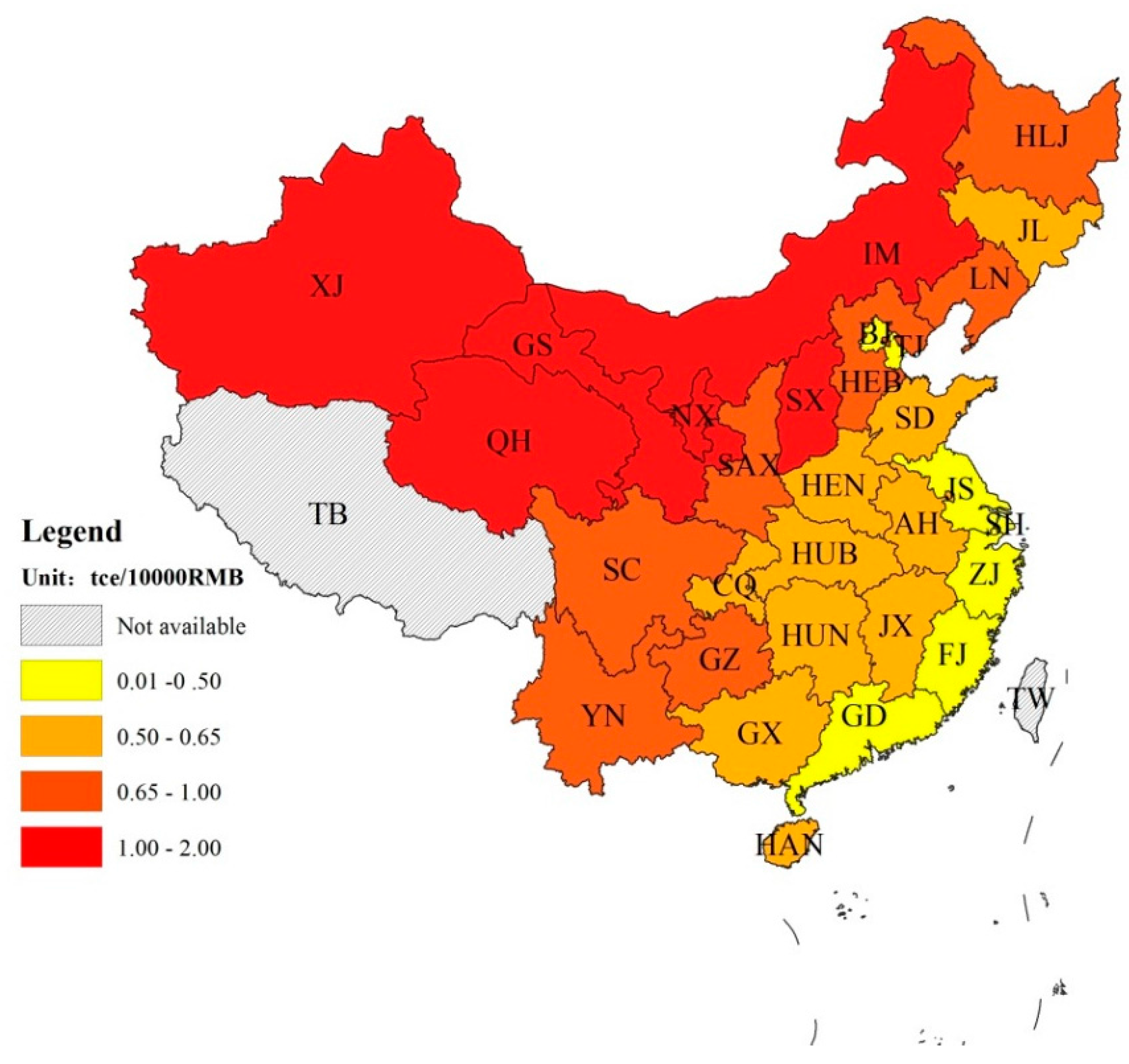
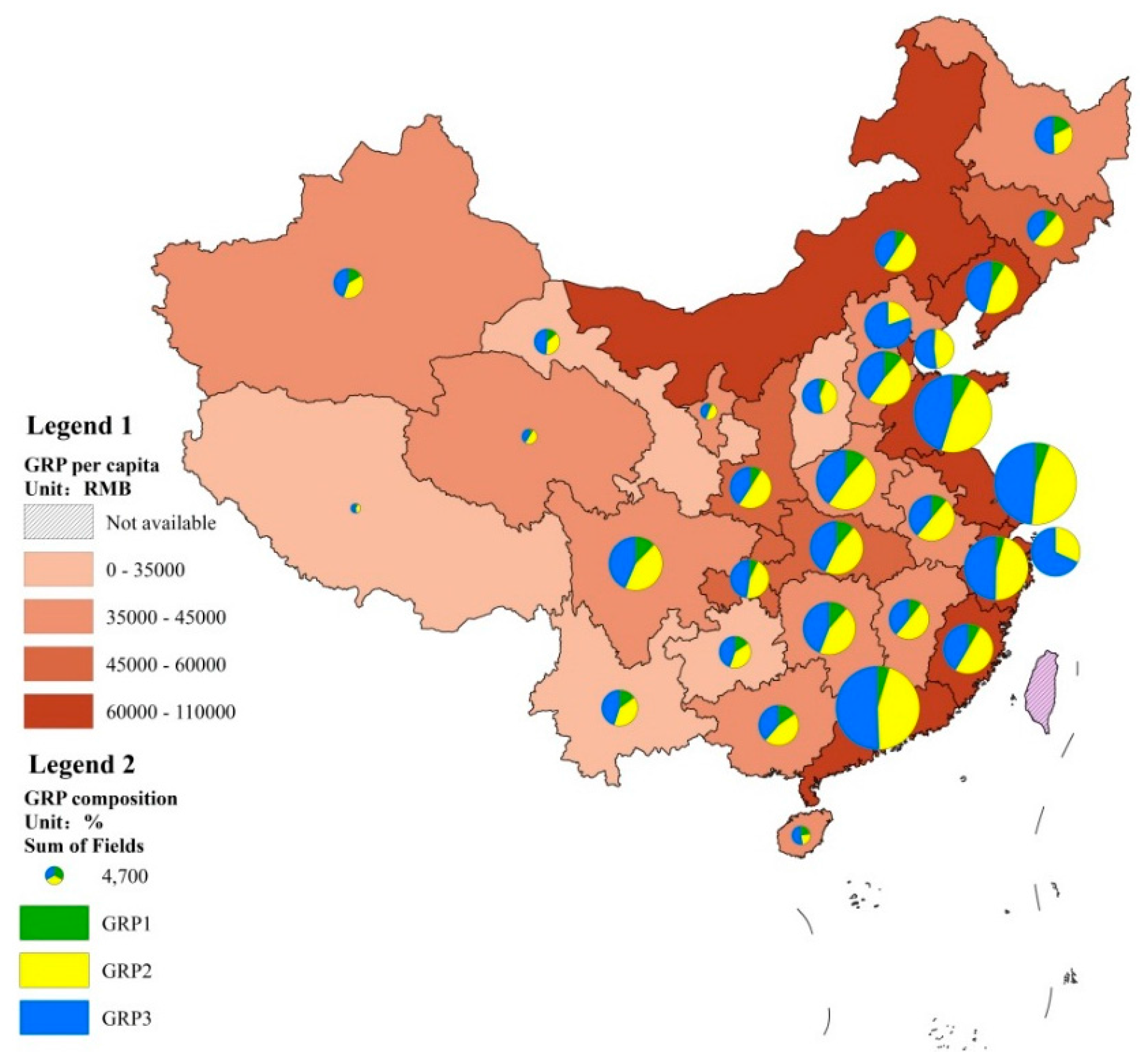
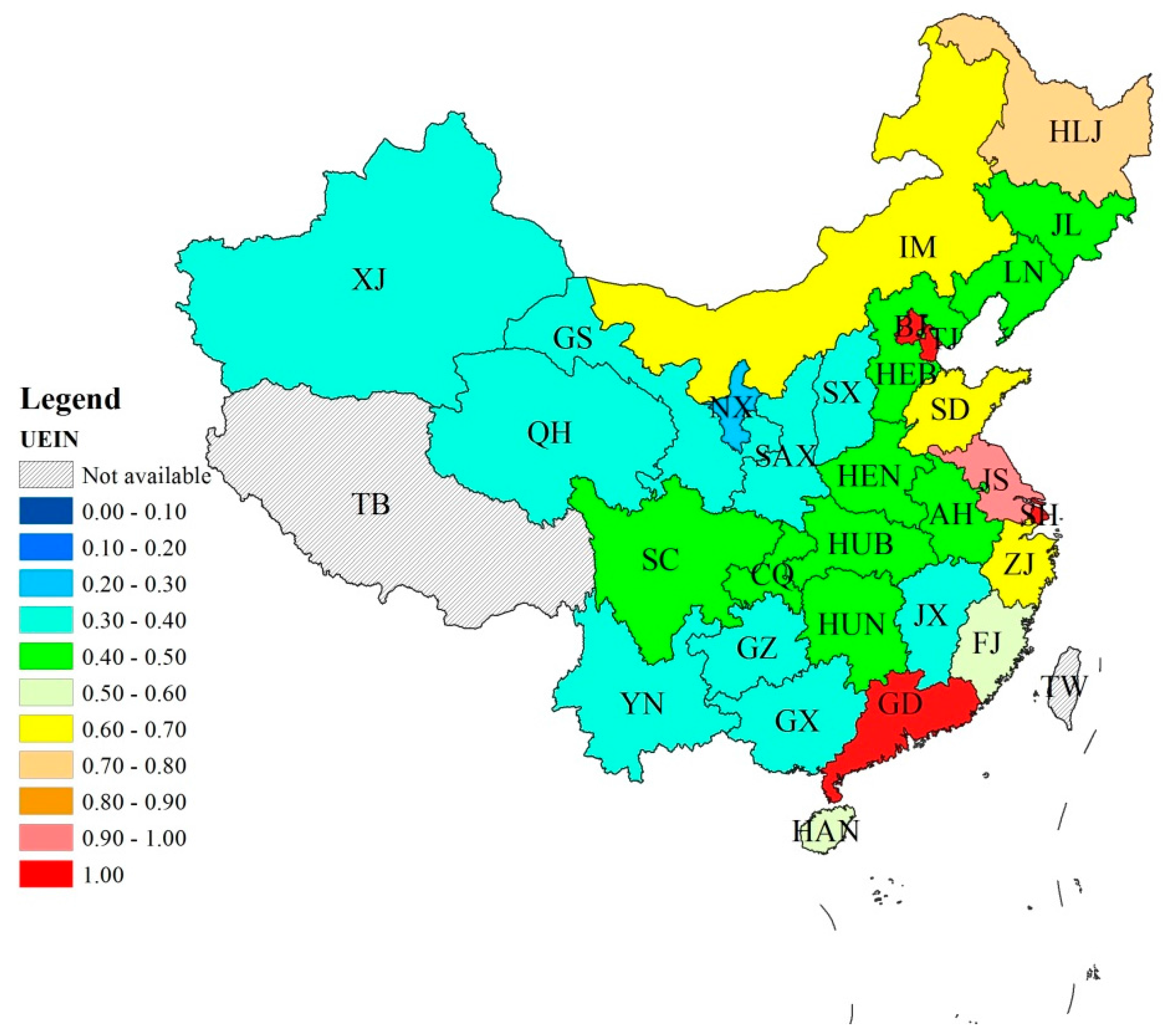
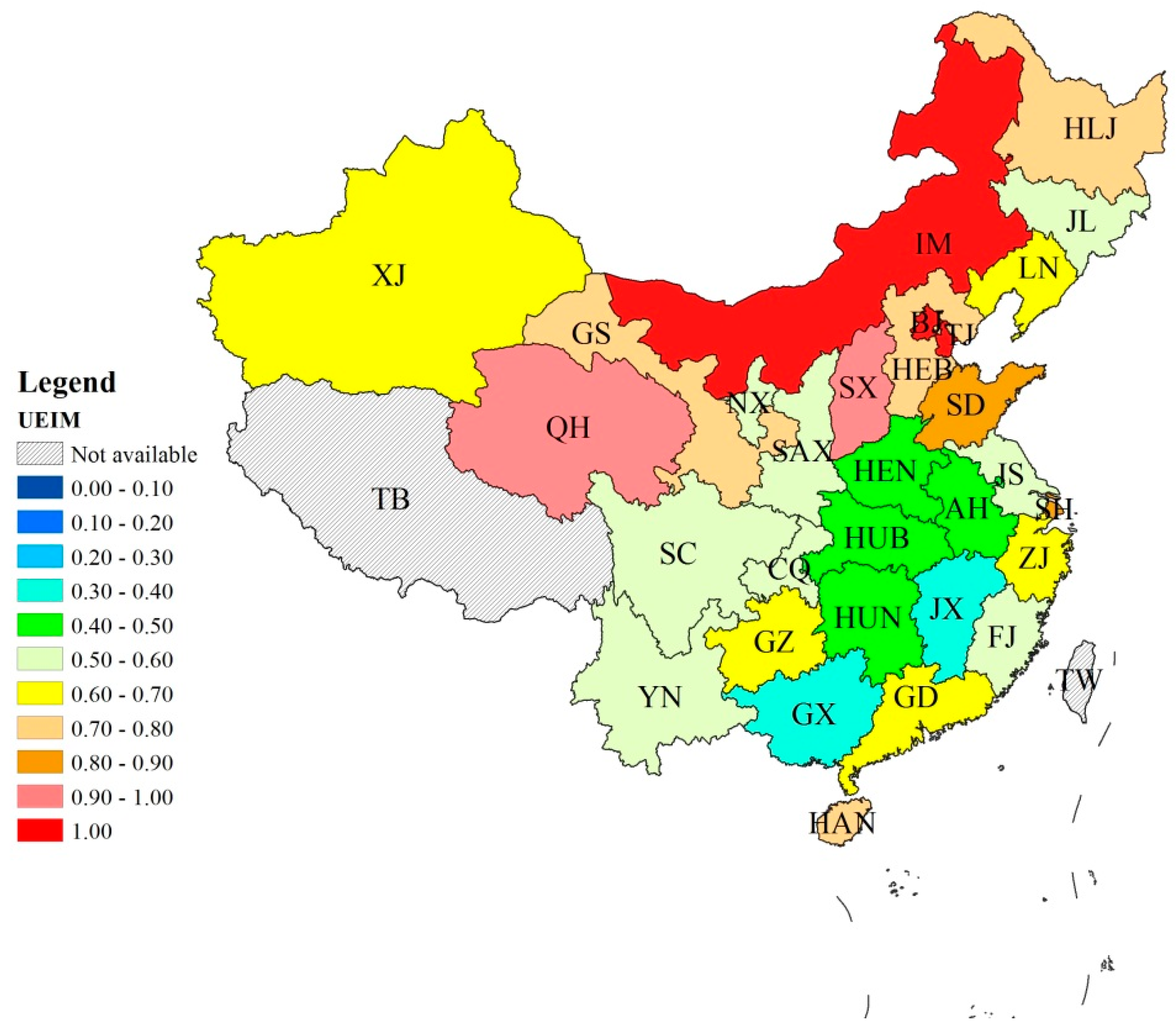
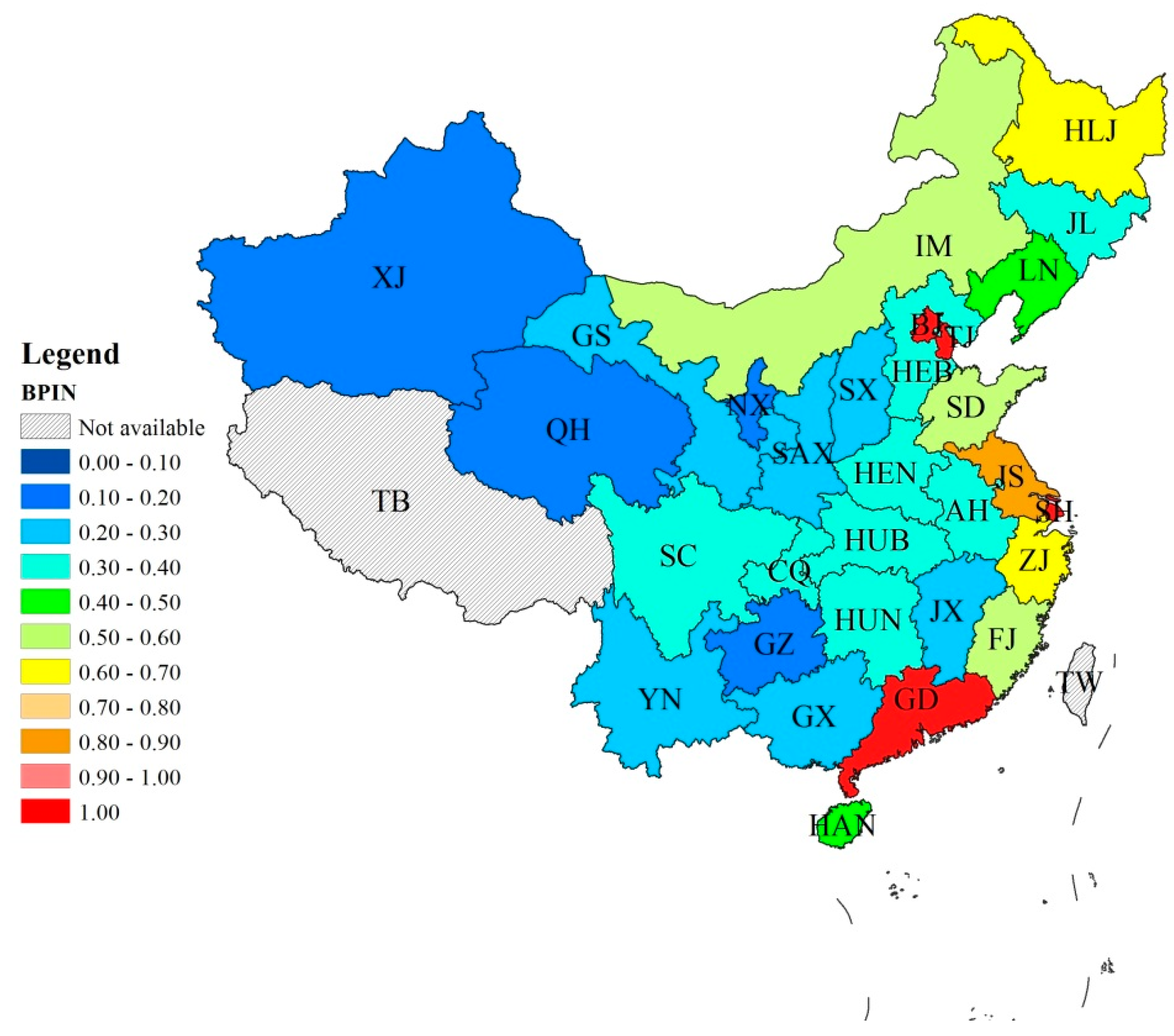
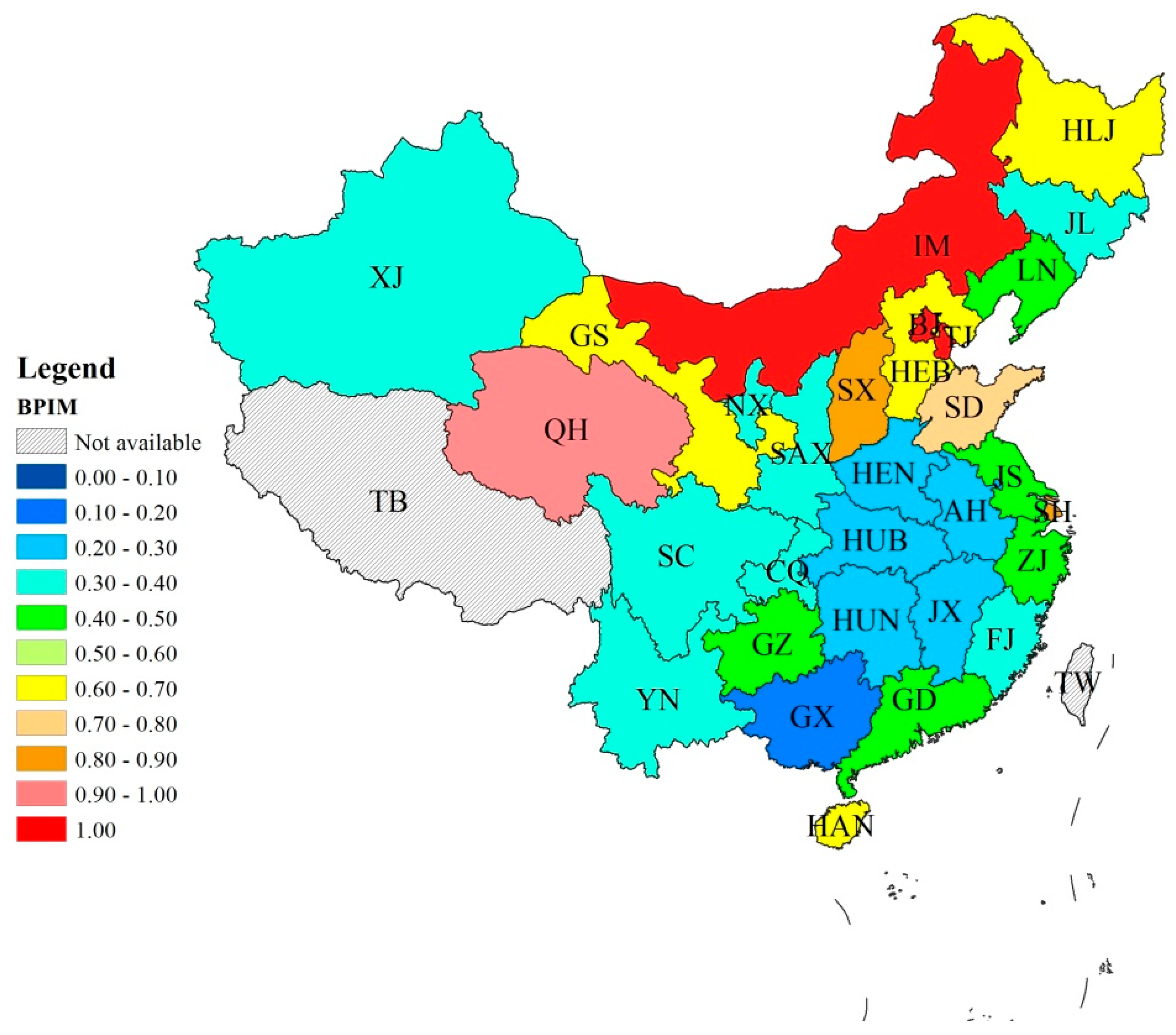
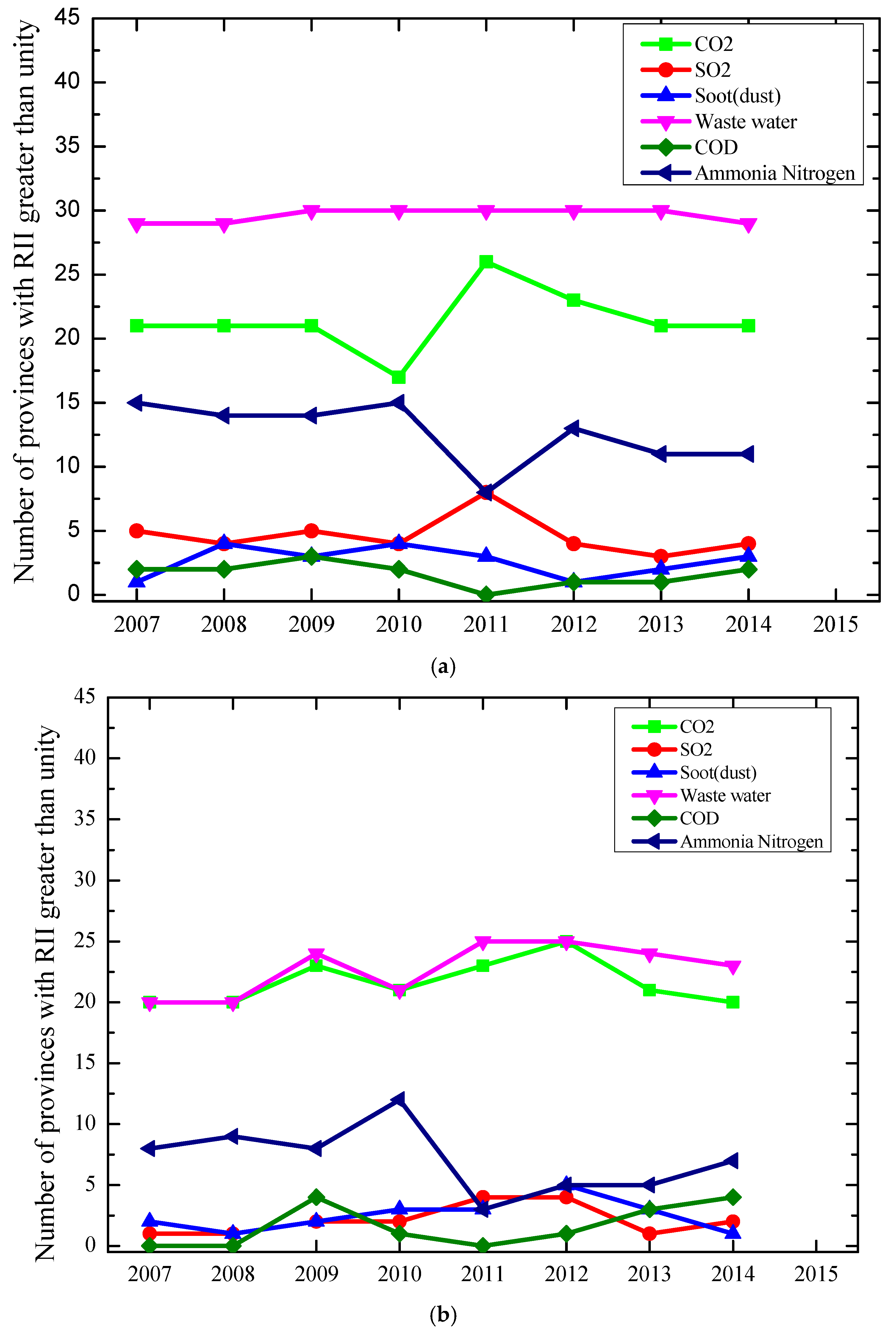

| Authors | Desirable Outputs | Undesirable Outputs | Production Inputs |
|---|---|---|---|
| [34] | GDP | SO2, COD, Nitrogen | Labor, capital, energy, water |
| [35] | GDP | CO2 | Labor, capital, energy |
| [36] | GDP | CO2, SO2 | Labor, capital, coal, crude oil, natural gas |
| [37] | Industrial added value | CO2 | Labor, capital, energy |
| [38] | GDP | Labor, capital, energy | |
| [39] | GDP | Waste water, waste gas, solid waste | Labor, capital, energy |
| [40] | Industrial added value | CO2, SO2 | Labor, capital, energy |
| [41] | Industrial added value | NO2 | Capital, electricity |
| [26] | GDP | CO2 | Labor, capital, energy |
| [42] | GDP | CO2, SO2 | Labor, capital, coal, electricity |
| [4] | GDP | CO2 | Labor, capital, energy |
| [43] | GDP | CO2 | Labor, capital, energy |
| [44] | GDP | Solid waste | Labor, capital, coal |
| [45] | GDP, primary secondary and tertiary industry | PM10, SO2, NO2 | Coal, oil, gas, electricity, energy investment |
| [46] | Industrial added value | Waste water, solid waste | Labor, capital, coal |
| [22] | Industrial added value | CO2 | Labor, capital, energy |
| [47] | GDP | SO2, solid waste | Labor, capital, energy |
| [48] | GDP | CO2, SO2, COD | Labor, capital, energy |
| [49] | GDP | CO2, SO2, solid waste, industrial dust | Labor, capital, energy |
| [50] | GDP | CO2 | Labor, capital, energy |
| [6] | GDP | CO2 | Labor, capital, energy |
| [51] | GDP | CO2, SO2 | Labor, capital, energy |
| [52] | GDP | SO2, waste water, solid waste | Labor, capital, energy |
| [53] | GDP | Coal, oil, gas, fixed investment |
| Indicator | Production Inputs | Desirable Outputs | Undesirable Outputs a | |||||||
|---|---|---|---|---|---|---|---|---|---|---|
| Capital | Labor | Energy | GRP | CO2 | SO2 | SD | WW | COD | AN | |
| 1010 RMB | 104 Persons | 106 tce | 1010 RMB | 107 Tons | 104 Tons | 104 Tons | 107 Tons | 104 Tons | 104 Tons | |
| Mean | 252 | 463 | 123 | 107 | 25 | 76 | 51 | 204 | 59 | 6 |
| Standard deviation | 208 | 303 | 79 | 93 | 17 | 44 | 36 | 162 | 41 | 4 |
| Minimum | 15 | 43 | 8 | 5 | 1 | 2 | 2 | 16 | 7 | 1 |
| Maximum | 1145 | 1973 | 389 | 514 | 77 | 200 | 182 | 905 | 198 | 23 |
| Windows | |||||||||
|---|---|---|---|---|---|---|---|---|---|
| 2005–2007 | 2006–2008 | 2007–2009 | 2008–2010 | 2009–2011 | 2010–2012 | 2011–2013 | 2012–2014 | Average | |
| GD | 1.000 | 1.000 | 1.000 | 1.000 | 1.000 | 1.000 | 1.000 | 1.000 | 1.000 |
| TJ | 1.000 | 1.000 | 1.000 | 1.000 | 1.000 | 1.000 | 1.000 | 1.000 | 1.000 |
| SH | 1.000 | 1.000 | 1.000 | 1.000 | 1.000 | 1.000 | 1.000 | 1.000 | 1.000 |
| BJ | 1.000 | 1.000 | 1.000 | 1.000 | 1.000 | 1.000 | 1.000 | 1.000 | 1.000 |
| JS | 1.000 | 1.000 | 1.000 | 1.000 | 1.000 | 1.000 | 0.641 | 0.640 | 0.910 |
| HLJ | 1.000 | 1.000 | 1.000 | 1.000 | 0.446 | 0.429 | 0.454 | 0.453 | 0.723 |
| ZJ | 0.774 | 0.763 | 0.736 | 0.727 | 0.611 | 0.638 | 0.643 | 0.659 | 0.694 |
| SD | 0.723 | 0.718 | 0.714 | 0.720 | 0.566 | 0.599 | 0.583 | 0.581 | 0.651 |
| IM | 1.000 | 0.496 | 0.491 | 0.485 | 0.441 | 1.000 | 0.463 | 0.442 | 0.602 |
| FJ | 0.657 | 0.616 | 0.592 | 0.591 | 0.494 | 0.530 | 0.556 | 0.567 | 0.575 |
| HAN | 0.588 | 0.553 | 0.576 | 0.617 | 0.518 | 0.530 | 0.506 | 0.495 | 0.548 |
| LN | 0.456 | 0.484 | 0.514 | 0.541 | 0.484 | 0.495 | 0.491 | 0.470 | 0.492 |
| HEB | 0.514 | 0.502 | 0.503 | 0.509 | 0.440 | 0.439 | 0.433 | 0.432 | 0.471 |
| CQ | 0.411 | 0.414 | 0.436 | 0.477 | 0.458 | 0.491 | 0.499 | 0.513 | 0.462 |
| JL | 0.405 | 0.433 | 0.469 | 0.483 | 0.452 | 0.485 | 0.473 | 0.464 | 0.458 |
| AH | 0.456 | 0.462 | 0.463 | 0.468 | 0.407 | 0.411 | 0.404 | 0.408 | 0.435 |
| SC | 0.413 | 0.394 | 0.424 | 0.440 | 0.438 | 0.472 | 0.436 | 0.445 | 0.433 |
| HUN | 0.401 | 0.395 | 0.399 | 0.401 | 0.404 | 0.416 | 0.425 | 0.436 | 0.410 |
| HUB | 0.377 | 0.386 | 0.415 | 0.429 | 0.395 | 0.415 | 0.416 | 0.422 | 0.407 |
| HEN | 0.412 | 0.403 | 0.422 | 0.430 | 0.391 | 0.405 | 0.386 | 0.385 | 0.404 |
| JX | 0.354 | 0.378 | 0.408 | 0.408 | 0.361 | 0.365 | 0.350 | 0.350 | 0.372 |
| SAX | 0.351 | 0.348 | 0.375 | 0.380 | 0.373 | 0.393 | 0.372 | 0.367 | 0.370 |
| YN | 0.402 | 0.395 | 0.393 | 0.387 | 0.319 | 0.328 | 0.331 | 0.341 | 0.362 |
| GX | 0.305 | 0.295 | 0.315 | 0.318 | 0.365 | 0.367 | 0.374 | 0.382 | 0.340 |
| GS | 0.361 | 0.333 | 0.345 | 0.338 | 0.318 | 0.328 | 0.327 | 0.325 | 0.334 |
| SX | 0.352 | 0.314 | 0.326 | 0.320 | 0.328 | 0.334 | 0.333 | 0.327 | 0.329 |
| XJ | 0.328 | 0.318 | 0.322 | 0.311 | 0.302 | 0.296 | 0.291 | 0.292 | 0.308 |
| QH | 0.292 | 0.290 | 0.295 | 0.297 | 0.309 | 0.323 | 0.325 | 0.325 | 0.307 |
| GZ | 0.298 | 0.302 | 0.313 | 0.319 | 0.293 | 0.299 | 0.305 | 0.296 | 0.303 |
| NX | 0.221 | 0.227 | 0.241 | 0.232 | 0.233 | 0.243 | 0.242 | 0.246 | 0.235 |
| Windows | Average | ||||||||
|---|---|---|---|---|---|---|---|---|---|
| 2005–2007 | 2006–2008 | 2007–2009 | 2008–2010 | 2009–2011 | 2010–2012 | 2011–2013 | 2012–2014 | ||
| IM | 1.000 | 1.000 | 1.000 | 1.000 | 1.000 | 1.000 | 1.000 | 1.000 | 1.000 |
| TJ | 1.000 | 1.000 | 1.000 | 1.000 | 1.000 | 1.000 | 1.000 | 1.000 | 1.000 |
| BJ | 1.000 | 1.000 | 1.000 | 1.000 | 1.000 | 1.000 | 1.000 | 1.000 | 1.000 |
| QH | 1.000 | 1.000 | 0.925 | 1.000 | 1.000 | 1.000 | 1.000 | 1.000 | 0.991 |
| SX | 1.000 | 1.000 | 1.000 | 1.000 | 0.791 | 0.795 | 1.000 | 1.000 | 0.948 |
| SH | 0.715 | 0.726 | 0.772 | 0.774 | 1.000 | 1.000 | 1.000 | 1.000 | 0.873 |
| SD | 1.000 | 1.000 | 0.879 | 1.000 | 0.648 | 0.674 | 0.660 | 0.649 | 0.814 |
| GS | 1.000 | 1.000 | 0.915 | 0.804 | 0.485 | 0.521 | 0.544 | 1.000 | 0.783 |
| HEB | 1.000 | 1.000 | 0.770 | 1.000 | 0.592 | 0.604 | 0.605 | 0.622 | 0.774 |
| HLJ | 1.000 | 1.000 | 1.000 | 1.000 | 0.538 | 0.540 | 0.553 | 0.557 | 0.774 |
| HAN | 1.000 | 1.000 | 1.000 | 0.626 | 0.562 | 0.576 | 0.564 | 0.527 | 0.732 |
| LN | 0.633 | 0.756 | 0.748 | 0.747 | 0.624 | 0.646 | 0.639 | 0.604 | 0.674 |
| GZ | 0.681 | 0.705 | 0.627 | 1.000 | 0.573 | 0.578 | 0.548 | 0.542 | 0.657 |
| XJ | 0.727 | 0.668 | 0.548 | 0.570 | 0.536 | 0.571 | 0.636 | 0.733 | 0.624 |
| GD | 0.566 | 0.567 | 0.617 | 0.622 | 0.607 | 0.630 | 0.621 | 0.596 | 0.603 |
| ZJ | 0.579 | 0.590 | 0.624 | 0.632 | 0.551 | 0.596 | 0.625 | 0.610 | 0.601 |
| JS | 0.549 | 0.568 | 0.619 | 0.616 | 0.543 | 0.588 | 0.635 | 0.628 | 0.593 |
| YN | 0.700 | 0.716 | 0.639 | 0.692 | 0.417 | 0.451 | 0.466 | 0.497 | 0.572 |
| NX | 0.614 | 0.614 | 0.556 | 0.516 | 0.488 | 0.536 | 0.558 | 0.585 | 0.559 |
| SC | 0.458 | 0.479 | 0.523 | 0.578 | 0.557 | 0.656 | 0.591 | 0.572 | 0.552 |
| JL | 0.513 | 0.530 | 0.548 | 0.584 | 0.516 | 0.564 | 0.551 | 0.534 | 0.542 |
| CQ | 0.429 | 0.422 | 0.458 | 0.558 | 0.566 | 0.616 | 0.579 | 0.600 | 0.528 |
| FJ | 0.511 | 0.514 | 0.540 | 0.549 | 0.475 | 0.527 | 0.542 | 0.546 | 0.526 |
| SAX | 0.494 | 0.502 | 0.505 | 0.541 | 0.485 | 0.523 | 0.527 | 0.526 | 0.513 |
| HEN | 0.439 | 0.485 | 0.484 | 0.520 | 0.453 | 0.477 | 0.472 | 0.478 | 0.476 |
| HUB | 0.415 | 0.425 | 0.458 | 0.499 | 0.457 | 0.511 | 0.499 | 0.502 | 0.471 |
| HUN | 0.354 | 0.378 | 0.408 | 0.448 | 0.472 | 0.478 | 0.453 | 0.454 | 0.431 |
| AH | 0.404 | 0.411 | 0.436 | 0.454 | 0.385 | 0.398 | 0.404 | 0.392 | 0.411 |
| JX | 0.364 | 0.375 | 0.401 | 0.391 | 0.348 | 0.365 | 0.363 | 0.362 | 0.371 |
| GX | 0.263 | 0.264 | 0.291 | 0.288 | 0.358 | 0.366 | 0.381 | 0.380 | 0.324 |
| Windows | Average | ||||||||
|---|---|---|---|---|---|---|---|---|---|
| 2005–2007 | 2006–2008 | 2007–2009 | 2008–2010 | 2009–2011 | 2010–2012 | 2011–2013 | 2012–2014 | ||
| GD | 1.000 | 1.000 | 1.000 | 1.000 | 1.000 | 1.000 | 1.000 | 1.000 | 1.000 |
| TJ | 1.000 | 1.000 | 1.000 | 1.000 | 1.000 | 1.000 | 1.000 | 1.000 | 1.000 |
| SH | 1.000 | 1.000 | 1.000 | 1.000 | 1.000 | 1.000 | 1.000 | 1.000 | 1.000 |
| BJ | 1.000 | 1.000 | 1.000 | 1.000 | 1.000 | 1.000 | 1.000 | 1.000 | 1.000 |
| JS | 1.000 | 1.000 | 1.000 | 1.000 | 1.000 | 1.000 | 0.581 | 0.579 | 0.895 |
| HLJ | 1.000 | 1.000 | 1.000 | 1.000 | 0.354 | 0.334 | 0.363 | 0.362 | 0.677 |
| ZJ | 0.736 | 0.723 | 0.692 | 0.681 | 0.546 | 0.578 | 0.583 | 0.602 | 0.643 |
| SD | 0.677 | 0.671 | 0.667 | 0.673 | 0.493 | 0.533 | 0.514 | 0.511 | 0.592 |
| IM | 1.000 | 0.412 | 0.406 | 0.400 | 0.348 | 1.000 | 0.373 | 0.349 | 0.536 |
| FJ | 0.600 | 0.552 | 0.524 | 0.523 | 0.410 | 0.452 | 0.482 | 0.495 | 0.505 |
| HAN | 0.520 | 0.478 | 0.505 | 0.554 | 0.438 | 0.452 | 0.424 | 0.411 | 0.473 |
| LN | 0.366 | 0.398 | 0.433 | 0.465 | 0.398 | 0.411 | 0.406 | 0.381 | 0.407 |
| HEB | 0.433 | 0.419 | 0.420 | 0.427 | 0.346 | 0.345 | 0.338 | 0.338 | 0.383 |
| CQ | 0.313 | 0.316 | 0.342 | 0.390 | 0.368 | 0.406 | 0.415 | 0.431 | 0.373 |
| JL | 0.305 | 0.339 | 0.380 | 0.397 | 0.361 | 0.399 | 0.385 | 0.375 | 0.368 |
| AH | 0.366 | 0.372 | 0.374 | 0.380 | 0.308 | 0.313 | 0.305 | 0.309 | 0.341 |
| SC | 0.315 | 0.293 | 0.328 | 0.346 | 0.344 | 0.384 | 0.342 | 0.353 | 0.338 |
| HUN | 0.301 | 0.294 | 0.299 | 0.301 | 0.305 | 0.319 | 0.329 | 0.342 | 0.311 |
| HUB | 0.273 | 0.284 | 0.317 | 0.334 | 0.295 | 0.317 | 0.319 | 0.325 | 0.308 |
| HEN | 0.314 | 0.303 | 0.326 | 0.335 | 0.290 | 0.306 | 0.284 | 0.282 | 0.305 |
| JX | 0.247 | 0.274 | 0.309 | 0.310 | 0.255 | 0.259 | 0.242 | 0.242 | 0.267 |
| SAX | 0.243 | 0.239 | 0.271 | 0.277 | 0.268 | 0.292 | 0.267 | 0.261 | 0.265 |
| YN | 0.302 | 0.294 | 0.292 | 0.284 | 0.206 | 0.216 | 0.220 | 0.232 | 0.256 |
| GX | 0.189 | 0.177 | 0.201 | 0.204 | 0.259 | 0.262 | 0.269 | 0.279 | 0.230 |
| GS | 0.255 | 0.222 | 0.235 | 0.228 | 0.204 | 0.216 | 0.214 | 0.212 | 0.223 |
| SX | 0.245 | 0.199 | 0.213 | 0.206 | 0.216 | 0.223 | 0.221 | 0.215 | 0.217 |
| XJ | 0.216 | 0.205 | 0.209 | 0.196 | 0.186 | 0.179 | 0.173 | 0.174 | 0.192 |
| QH | 0.174 | 0.171 | 0.177 | 0.180 | 0.194 | 0.210 | 0.212 | 0.213 | 0.191 |
| GZ | 0.181 | 0.186 | 0.199 | 0.205 | 0.175 | 0.182 | 0.189 | 0.178 | 0.187 |
| NX | 0.106 | 0.106 | 0.116 | 0.104 | 0.133 | 0.116 | 0.137 | 0.121 | 0.117 |
| Windows | Average | ||||||||
|---|---|---|---|---|---|---|---|---|---|
| 2005–2007 | 2006–2008 | 2007–2009 | 2008–2010 | 2009–2011 | 2010–2012 | 2011–2013 | 2012–2014 | ||
| IM | 1.000 | 1.000 | 1.000 | 1.000 | 1.000 | 1.000 | 1.000 | 1.000 | 1.000 |
| TJ | 1.000 | 1.000 | 1.000 | 1.000 | 1.000 | 1.000 | 1.000 | 1.000 | 1.000 |
| BJ | 1.000 | 1.000 | 1.000 | 1.000 | 1.000 | 1.000 | 1.000 | 1.000 | 1.000 |
| QH | 1.000 | 1.000 | 0.724 | 1.000 | 1.000 | 1.000 | 1.000 | 1.000 | 0.966 |
| SX | 1.000 | 1.000 | 1.000 | 1.000 | 0.530 | 0.496 | 1.000 | 1.000 | 0.878 |
| SH | 0.602 | 0.595 | 0.641 | 0.634 | 1.000 | 1.000 | 1.000 | 1.000 | 0.809 |
| SD | 1.000 | 1.000 | 0.686 | 1.000 | 0.470 | 0.502 | 0.491 | 0.480 | 0.704 |
| HLJ | 1.000 | 1.000 | 1.000 | 1.000 | 0.360 | 0.359 | 0.380 | 0.381 | 0.685 |
| GS | 1.000 | 1.000 | 0.779 | 0.566 | 0.283 | 0.304 | 0.321 | 1.000 | 0.657 |
| HAN | 1.000 | 1.000 | 1.000 | 0.470 | 0.384 | 0.392 | 0.376 | 0.340 | 0.620 |
| HEB | 1.000 | 1.000 | 0.475 | 1.000 | 0.350 | 0.365 | 0.357 | 0.379 | 0.616 |
| GD | 0.474 | 0.463 | 0.510 | 0.511 | 0.509 | 0.555 | 0.491 | 0.461 | 0.497 |
| ZJ | 0.462 | 0.466 | 0.518 | 0.503 | 0.432 | 0.498 | 0.459 | 0.449 | 0.473 |
| LN | 0.406 | 0.558 | 0.535 | 0.515 | 0.411 | 0.441 | 0.437 | 0.397 | 0.462 |
| JS | 0.410 | 0.422 | 0.484 | 0.461 | 0.405 | 0.462 | 0.475 | 0.470 | 0.449 |
| GZ | 0.407 | 0.431 | 0.366 | 1.000 | 0.335 | 0.337 | 0.320 | 0.316 | 0.439 |
| XJ | 0.479 | 0.413 | 0.320 | 0.332 | 0.313 | 0.333 | 0.385 | 0.531 | 0.388 |
| FJ | 0.382 | 0.376 | 0.396 | 0.402 | 0.342 | 0.403 | 0.382 | 0.381 | 0.383 |
| JL | 0.324 | 0.335 | 0.355 | 0.391 | 0.344 | 0.389 | 0.381 | 0.368 | 0.361 |
| YN | 0.452 | 0.471 | 0.396 | 0.444 | 0.243 | 0.263 | 0.272 | 0.290 | 0.354 |
| CQ | 0.256 | 0.249 | 0.277 | 0.353 | 0.370 | 0.429 | 0.407 | 0.417 | 0.345 |
| SC | 0.267 | 0.279 | 0.309 | 0.357 | 0.345 | 0.424 | 0.379 | 0.355 | 0.339 |
| NX | 0.358 | 0.358 | 0.324 | 0.301 | 0.285 | 0.313 | 0.326 | 0.341 | 0.326 |
| SAX | 0.303 | 0.313 | 0.315 | 0.346 | 0.307 | 0.341 | 0.334 | 0.328 | 0.323 |
| HEN | 0.259 | 0.289 | 0.291 | 0.314 | 0.275 | 0.297 | 0.284 | 0.289 | 0.287 |
| HUB | 0.242 | 0.248 | 0.267 | 0.292 | 0.271 | 0.302 | 0.311 | 0.307 | 0.280 |
| AH | 0.254 | 0.256 | 0.280 | 0.290 | 0.241 | 0.245 | 0.243 | 0.235 | 0.256 |
| HUN | 0.206 | 0.221 | 0.240 | 0.262 | 0.282 | 0.279 | 0.273 | 0.274 | 0.255 |
| JX | 0.230 | 0.238 | 0.262 | 0.249 | 0.217 | 0.227 | 0.220 | 0.219 | 0.233 |
| GX | 0.153 | 0.154 | 0.170 | 0.168 | 0.215 | 0.217 | 0.224 | 0.222 | 0.190 |
© 2018 by the authors. Licensee MDPI, Basel, Switzerland. This article is an open access article distributed under the terms and conditions of the Creative Commons Attribution (CC BY) license (http://creativecommons.org/licenses/by/4.0/).
Share and Cite
Zhang, A.; Li, A.; Gao, Y. Social Sustainability Assessment across Provinces in China: An Analysis of Combining Intermediate Approach with Data Envelopment Analysis (DEA) Window Analysis. Sustainability 2018, 10, 732. https://doi.org/10.3390/su10030732
Zhang A, Li A, Gao Y. Social Sustainability Assessment across Provinces in China: An Analysis of Combining Intermediate Approach with Data Envelopment Analysis (DEA) Window Analysis. Sustainability. 2018; 10(3):732. https://doi.org/10.3390/su10030732
Chicago/Turabian StyleZhang, Aizhen, Aijun Li, and Yaping Gao. 2018. "Social Sustainability Assessment across Provinces in China: An Analysis of Combining Intermediate Approach with Data Envelopment Analysis (DEA) Window Analysis" Sustainability 10, no. 3: 732. https://doi.org/10.3390/su10030732
APA StyleZhang, A., Li, A., & Gao, Y. (2018). Social Sustainability Assessment across Provinces in China: An Analysis of Combining Intermediate Approach with Data Envelopment Analysis (DEA) Window Analysis. Sustainability, 10(3), 732. https://doi.org/10.3390/su10030732





